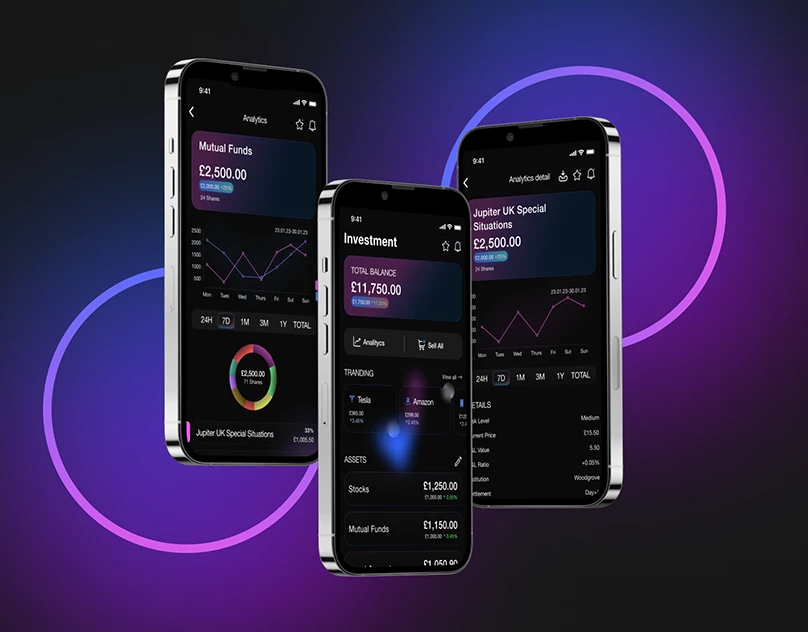Investment apps have become increasingly popular in recent years, revolutionizing the way individuals manage their finances and invest their money. These mobile applications provide users with convenient and accessible platforms to invest, monitor their portfolios, and stay updated with market trends. Whether you are a mobile app development company, AI development company, or a fintech app development company, this comprehensive guide will provide insights into investment apps and their development process.
What are Investment Apps?
Investment apps are mobile applications that empower users to invest their money in various financial instruments, such as stocks, bonds, mutual funds, and exchange-traded funds (ETFs). These apps offer a user-friendly interface and provide access to a wide range of investment opportunities, enabling users to make informed investment decisions with ease.
Investment Apps Market Insights – Latest Facts
The investment app market has experienced rapid growth in recent years. Here are some key insights into the current state of investment apps:
-
Increasing User Adoption: The popularity of investment apps is on the rise, with a growing number of individuals embracing these platforms for their investment needs. This trend can be attributed to the convenience, accessibility, and user-friendly interfaces offered by investment apps.
-
Democratization of Investing: Investment apps have played a significant role in democratizing investing. They have made it easier for individuals with limited financial knowledge or resources to enter the investment world, as these apps provide educational resources, guidance, and simplified investment options.
-
Rise of Robo-Advisors: Robo-advisors, powered by AI and machine learning algorithms, have gained traction within investment apps. These automated investment platforms offer personalized investment strategies based on user preferences, risk tolerance, and financial goals, making investing more efficient and tailored to individual needs.
Also check: Top 10 Fintech Trends
Types of Investment Apps
There are various types of investment apps catering to different investment approaches and user preferences. Here are a few common types:
-
Brokerage Apps: These apps enable users to buy and sell securities, such as stocks, bonds, and ETFs, directly from their mobile devices. They often provide real-time market data, research tools, and trading functionalities.
-
Robo-Advisor Apps: Robo-advisor apps use algorithms and AI technology to provide automated investment advice and portfolio management services. These apps typically offer low-cost investment options and personalized investment strategies.
-
Social Trading Apps: Social trading apps combine investment platforms with social networking features. Users can follow and copy trades of successful investors, share insights, and engage in discussions with other investors.
Investment Apps Features – Basic & Advanced:
When developing an investment app, it is crucial to include key features that enhance user experience and provide value. Here are some basic and advanced features to consider:
Basic Features
-
User registration and authentication
-
Account linking and portfolio tracking
-
Real-time market data and stock quotes
-
Watchlist creation and alerts
-
Investment order placement and execution
-
Secure payment integration
Advanced Features
-
Robo-advisor functionality with personalized investment recommendations
-
Investment education and resources
-
Social trading features for users to interact and learn from other investors
-
News and market analysis updates
-
Customizable investment tracking and reporting
-
Integration with external financial services, such as banking and tax platforms
Also read: Top Fintech App Development Companies
How to Develop a Mobile Investment App?
Developing a mobile investment app requires careful planning and execution. Here’s a step-by-step guide to help you create an investment app:
1. Define Objectives: Clearly define the objectives, target audience, and unique selling points of your investment app.
2. Conduct Market Research: Analyze the market, identify user needs, study competitor apps, and stay updated with industry trends.
3. Design the User Experience: Create wireframes and design the user interface (UI) and user experience (UX) of your app. Prioritize ease of use, intuitive navigation, and seamless transactions.
4. Choose a Reliable Development Partner: Collaborate with a reputable mobile app development company. Ensure they have experience in developing investment apps and can provide technical expertise.
5. Develop the Backend Infrastructure: Build a robust backend infrastructure that can handle user data securely, integrate with financial APIs, and support real-time market data updates.
6. Front-end Development: Implement the front-end of your app, focusing on responsive design and seamless user interactions. Conduct thorough testing to address any bugs or performance issues.
7. Launch and Marketing: Prepare for the launch of your app on major platforms like iOS and Android. Adhere to platform guidelines and employ effective marketing strategies to promote your investment app.
8. Continuous Improvement: Gather user feedback and continuously update and improve your app based on user needs and market trends. Stay agile and adapt to the evolving investment landscape.
Conclusion
Investment apps have transformed the way individuals invest and manage their finances. Whether you are a financial app development company, understanding the intricacies of investment app development is crucial to meeting the needs of modern investors. By incorporating the right features and partneringwith the right development experts, you can create a user-friendly and effective investment app that empowers users to make informed investment decisions and achieve their financial goals. Stay updated with market trends, embrace technological advancements, and provide a seamless user experience to stand out in the competitive investment app landscape.



